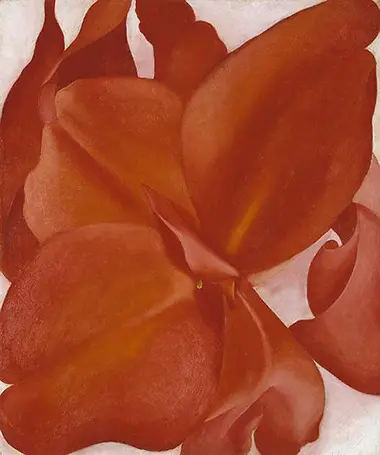Painted in 1927, it is typical of what is considered to be O'Keeffe's unique style. A fascinating blend of realism and expressionism, Red Cannas uses vibrant colour to engage the eye and capture the essence of the flower.
O'Keeffe knew from a very early age that she wanted to be an artist. Working in watercolours to start with, she then moved on to working in oils. She was initially inspired and trained by Arthur Wesley Dow before meeting Alfred Stieglitz her future husband, as well as the other leading American Modernists of the time.
The photography of Stieglitz, along with Paul Strand led to what was possibly O'Keeffe's greatest innovation, the close-up framing of her subject matter.
Red Cannas uses this technique of magnifying her subject on a large scale with great effect. The flower fills the frame leaving some of the flower entirely out of the picture.
O'Keeffe utilises a play of colour and light to highlight the contours of the petals in a dynamic testament to nature.
The first female artist to achieve worldwide fame, O'Keeffe was known as the Mother of American Modernism, and went on to remain a fiercely independent artist for most of her life.
Many critics tried to appropriate her work as sexual and erotic, and described her work in feminist terms. O'Keefe herself vehemently denied such claims, rather, her work tried to capture nature itself.
She was compelled to show these tiny flowers in all their glory on a large scale in order to try to help people focus on the importance of the moment, to make them stop their hurried minds just for a short time at least.
O'Keeffe once said; 'Painting is my language. It is the way I speak'.
